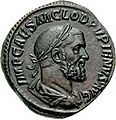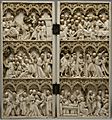Bas-relief facts for kids
Bas-relief is a special way of making sculpture where the carved figures don't stick out very far from the flat background. Think of it like a picture that's also a little bit 3D! The shapes of the figures look natural, and you can see the artwork clearly from many different angles.
This technique makes the art look almost flat, but with enough depth to show details. It's a very old art form, used for thousands of years.
What is Bas-Relief?
Bas-relief is also known as "low relief." The word "bas" comes from French and means "low." So, it literally means "low sculpture." In this style, the figures are only slightly raised from the surface. They don't pop out much, maybe just a few centimeters (or inches) at most.
This makes the artwork look like it's part of the wall or surface it's carved into. Artists use this method to create scenes that look realistic but don't take up much space.
Bas-Relief vs. High Relief
There's another type of relief called "high relief," or altorilievo. This is the opposite of bas-relief. In high relief, the figures stick out much more from the background. Sometimes, parts of the figures, like heads or arms, might even be completely detached from the background.
High relief can create a much deeper and more dramatic effect. Bas-relief is often used for smaller details or when many figures need to be shown together. High relief is great for showing powerful, individual figures.
Famous Examples of Bas-Relief
One of the most amazing examples of bas-relief art comes from ancient Assyria. These are the Assyrian Lion Hunt Reliefs. You can see them at the British Museum in London. These carvings show kings hunting lions with incredible detail. The artists made the lions look like they are truly moving, which was very impressive for the time they were made, around 645-635 BC.
Another famous example is the Gates of Paradise by Lorenzo Ghiberti in Florence, Italy. These bronze doors have many panels that combine both high and low relief. The main figures are in high relief, while the backgrounds are in low relief, creating a sense of depth.
Ancient Romans also used bas-relief a lot. The Ara Pacis in Rome has beautiful low-relief carvings. These carvings were placed so people could see them easily from below.
How Bas-Relief is Made
Artists create bas-reliefs by carving away the material around the figures. This leaves the figures slightly raised. They can use different materials like stone, wood, metal, or clay. The skill of the artist is in making the figures look natural and detailed, even with such little depth.
Sometimes, artists even use a technique called "sunk-relief." In sunk-relief, the figures are carved *into* the surface, rather than raised from it. This means the main background isn't removed, only the area right around the sculpted shape. This style was popular in ancient Egypt.
Related pages
Images for kids
-
Side view of Lorenzo Ghiberti's cast gilt-bronze Gates of Paradise at the Florence Baptistery in Florence, Italy, combining high-relief main figures with backgrounds mostly in low relief
-
A face of the high-relief Frieze of Parnassus round the base of the Albert Memorial in London. Most of the heads and many feet are completely undercut, but the torsos are "engaged" with the surface behind
-
Low-relief on Roman sestertius, 238 AD
-
A low-relief dating to circa 2000 BC, from the kingdom of Simurrum, modern Iraq
-
High-relief deities at Khajuraho, India
-
French Gothic diptych, 25 cm (9.8 in) high, with crowded scenes from the Life of Christ, c. 1350–1365
-
Persian low or bas-relief in Persepolis – a symbol of Zoroastrian Nowruz – at the spring equinox the power of the bull (personifying Earth) and lion (personifying the Sun) are equal.
-
Assyrian low relief, Lion Hunt of Ashurbanipal, North Palace, Nineveh
-
Atropos cutting the thread of life. Ancient Greek low relief
-
Donatello, Madonna and Child in rilievo stiacciato or shallow relief














